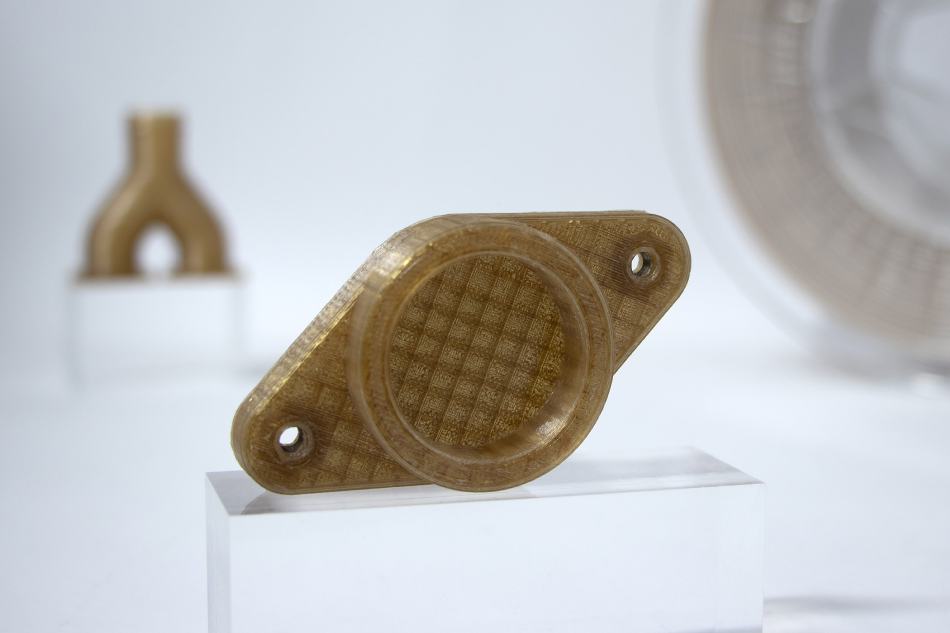Victrex, a global leader in high-performance polyetheretherketone (PEEK) and polyaryletherketone (PAEK) polymer solutions, has launched VICTREX AM™ 200 filament. The new offering has been specifically developed and optimised for additive manufacturing (AM).
 Different parts printed with VICTREX AM™ 200 filament © INTAMSYS
Different parts printed with VICTREX AM™ 200 filament © INTAMSYS
The PEEK incumbent materials on the market today, although used in some AM applications, were designed for conventional manufacturing methods, such as machining and injection molding. The first 3D printing equipment supplier to offer Victrex´s new AM PAEK filament is INTAMSYS, China, a world-leading high-tech company that provides high-performance 3D printing materials, direct additive manufacturing solutions and software.
Jakob Sigurdsson, Victrex CEO comments: “This new generation of Victrex additive manufacturing PAEK filament represents an important step forward for Victrex and we are excited now to work closely with INTAMSYS. Due to excellent cooperation with companies and institutions that pursue innovation in additive manufacturing, such as INTAMSYS, as well as Victrex´s continued research, we have been making sustained progress toward creating truly innovative components based on the design freedom of additive manufacturing, combined with the high performance of PAEK polymers."
The PAEK-based new VICTREX AM filament has been designed and optimized specifically for AM. The excellent mechanical properties of PAEK are in demand for high performance parts. However, until now they were difficult to be fully realized in 3D printed parts with existing choices such as PEEK and PEKK. For example, repurposing injection molding PEEK into filament fusion AM, typically results in weak parts because of poor interlayer bonding. This new material is designed to address this weakness in printing PEEK. According to INTAMSYS´ experience using its manufacturing equipment, the VICTREX AM 200 filament has a higher Z-axis strength and has shown to date up to 80% strength in the XY direction with a better fused filament forming (FFF) printing adaptability than the existing PAEK materials.
INTAMSYS has conducted physical and mechanical performance tests on the new VICTREX PAEK filament material. The tests were performed on different printers including the smart dual nozzle FUNMAT PRO 410 3D printer. This industrial grade, high temperature 3D printer can print parts up to 305*305*406 mm, can handle a variety of complex structures, and can print a variety of materials such as PEEK, PEEK-CF, PEKK, PC, PC-ABS, and other high performance materials.
“Our test results to date have shown that the VICTREX AM 200 filament has a better interlayer adhesion than other PAEK materials on INTAMSYS´ machines. Compared with unfilled PEEK, it is designed with slower crystallization, lower melt temperature, and a viscosity fine tuned to the filament fusion process, such as easier flow in the build chamber after leaving the nozzle. Higher flow in open air (low shear rates) also promotes interlayer bonding and stability during printing,” said Charles Han, Founder and CEO at INTAMSYS.“ All of this contributes to an improved interlaminar adhesion, easier printing (less shrink and warp), and a better suitability for FDM 3D printing, compared to other similar options, based upon the testing we have done at INTAMSYS up to this point.”
INTAMSYS is also the first company to be part of Victrex´s proposed filament fusion network supporting this new filament. The network aims to facilitate the use of the innovative high performance VICTREX AM materials based on PAEK polymers, and includes further material solutions specifically developed for use in additive manufacturing technology. These materials are designed for high temperature resistance requirements with excellent mechanical properties for AM parts.
Victrex´s new PAEK AM filament has been developed to support a variety of demanding applications because of its very high wear resistance, high temperature resistance, fatigue resistance, and corrosion resistance to fluid/chemical, which when combined have the potential to increase design freedom and production cost efficiency.